Rework and restraint
I got to the Metropolitan Museum of Art just in time to see Matisse: In Search of True Painting, the tremendous show which just ended, built around the French painter’s tendency to exhaustively try different variations on a theme. When he did this, and he did it a lot, I’ve never been sure whether he was trying to get something exactly right or simply exploring every possible way to render an image, the way many artists have repeatedly returned to the same image again and again: Monet’s haystacks and cathedrals, Warhol’s various riffs on a particular iconic image and Motherwell’s repeated reworkings of Ode to a Spanish Republic. In the case of Matisse, I’m never quite sure I like the later versions of particular paintings more than earlier ones. In some cases, I get less and less interested, the further he simplifies and refines a motif. But almost everything in this show seemed to be offering itself to me from a fresh, new angle. This was especially true of the first painting, Still Life With Compote and Fruit, one of the 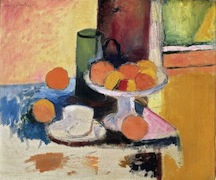 artist’s earliest paintings, whose incredibly subtle color—impossible to fully appreciate in the catalog—made me want to stay there at the entry into the show and skip whatever else was coming. It’s unfinished, and yet it’s as fine a painting as any he ever did, with incredibly delicate feeling in the balance between the two sections of muted green against the peach and salmon colors of the fruit. The tug-of-war between illusions of depth and the flat and uniform areas of color—an energizing opposition at the heart of what gives life to Matisse’s work—imbues the image with a dreamlike quality that seems to breathe as you keep your eye on its cluster of simple objects that reminded me of Morandi. And that was only the start. This show was a thrill, from start to finish, and taught me at least as much about the way Matisse painted as any other exhibition of his work I’ve seen, including MOMA’s Matisse: Radical Invention 1913-1917 which gave me an awed respect for the monumental paintings he did after his return from Morocco.
artist’s earliest paintings, whose incredibly subtle color—impossible to fully appreciate in the catalog—made me want to stay there at the entry into the show and skip whatever else was coming. It’s unfinished, and yet it’s as fine a painting as any he ever did, with incredibly delicate feeling in the balance between the two sections of muted green against the peach and salmon colors of the fruit. The tug-of-war between illusions of depth and the flat and uniform areas of color—an energizing opposition at the heart of what gives life to Matisse’s work—imbues the image with a dreamlike quality that seems to breathe as you keep your eye on its cluster of simple objects that reminded me of Morandi. And that was only the start. This show was a thrill, from start to finish, and taught me at least as much about the way Matisse painted as any other exhibition of his work I’ve seen, including MOMA’s Matisse: Radical Invention 1913-1917 which gave me an awed respect for the monumental paintings he did after his return from Morocco.
Yet I’m not sure I absorbed what this show was curated to emphasize.  My fascination wasn’t with the way he refined or experimented with an image as he tried successive versions of it. Instead, the exhibit opened my eyes about seemingly minor aspects of particular works I’ve seen in reproductions over the years. Again and again, what I thought was familiar work looked new to me in the context of the other work on view. Being able to get very close to the surface of these paintings offered me the ability to see Matisse often handled paint much differently from what I’d thought. Wrongly, I’ve usually thought he painted alla prima, trusting his initial instincts with paint and rarely going back over his spontaneous choices of color and value—once and done, as it were, as is always the case in those films of him as he does a line drawing of a model’s face. I came away convinced that, in many cases, he spent a great deal of time reworking individual paintings, sometimes letting previous layers of paint show through more recent ones in ways that simply get lost in reproductions. You can’t see the pentimento in the color plates. And some of his more abstract compositions stood out in a way that made me question what I’ve always valued most in his work—especially the way I’ve favored his classic middle period, the seemingly comfy, bourgeois, less radical views in and around his apartment in Nice. I still think I have more to learn from that period, as a painter, and it offers more of a starting point for anyone grappling with representational painting. Yet, for the first time, with this show, I found myself relieved to see a dramatically simplified image appear after I’d been immersed in the softer and more natural interiors, still lifes and figures. I was pleasantly stunned by how powerful his more abstract work looked, compared to the painterly Riviera interiors I’ve always favored.
My fascination wasn’t with the way he refined or experimented with an image as he tried successive versions of it. Instead, the exhibit opened my eyes about seemingly minor aspects of particular works I’ve seen in reproductions over the years. Again and again, what I thought was familiar work looked new to me in the context of the other work on view. Being able to get very close to the surface of these paintings offered me the ability to see Matisse often handled paint much differently from what I’d thought. Wrongly, I’ve usually thought he painted alla prima, trusting his initial instincts with paint and rarely going back over his spontaneous choices of color and value—once and done, as it were, as is always the case in those films of him as he does a line drawing of a model’s face. I came away convinced that, in many cases, he spent a great deal of time reworking individual paintings, sometimes letting previous layers of paint show through more recent ones in ways that simply get lost in reproductions. You can’t see the pentimento in the color plates. And some of his more abstract compositions stood out in a way that made me question what I’ve always valued most in his work—especially the way I’ve favored his classic middle period, the seemingly comfy, bourgeois, less radical views in and around his apartment in Nice. I still think I have more to learn from that period, as a painter, and it offers more of a starting point for anyone grappling with representational painting. Yet, for the first time, with this show, I found myself relieved to see a dramatically simplified image appear after I’d been immersed in the softer and more natural interiors, still lifes and figures. I was pleasantly stunned by how powerful his more abstract work looked, compared to the painterly Riviera interiors I’ve always favored.
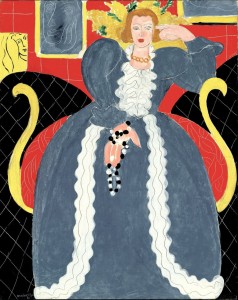 I first saw a reproduction of The Large Blue Dress at least thirty years ago, and I’ve seen it many times since then, but when I finally approached the actual painting in this show, it was almost startling, coming after a long series of the softer, looser still lifes and interiors and odalisques I’ve always loved. Suddenly, with The Large Blue Dress, Matisse seems to take a huge, sudden leap in the direction of his late cut-outs, reducing color to sharp-edged areas of flat uniform hue. It’s as if he decided to have his model get dressed for once, stand at attention and salute, and he paints her with utter clarity, simplicity and absolute confidence in his flat patterns of nearly uniform color in gentle, symmetrical curves. In this case, the work really does look alla prima. Grids and floral shapes are scratched quickly into the paint with a knife, and the almost austere scheme of primaries—along with white and black—help concentrate all his feeling into only two small areas of flesh tone and ocher, for face and hands and hair, along with a few tiny notes of green in what appears to be a forsythia bouquet behind his model’s head. A painting I previously considered a routine example of what you go to Matisse for—balance, pleasure, and beauty—now looks like to me like a brilliant fusion of his painterly work in Nice with the abstract rigor of the huge, nearly-abstract, post-Morocco compositions—and a glance forward to the cut-outs. There’s a tremendous sense of living presence in the model’s pose and expression, as if she’s ready to mutter an affectionately sardonic aside to the painter as he works. You get a sense of unpredictable life, as if something might happen if you look away, which takes command of the geometric rigor and flatness of the image. Again, I think that exact tension is what gives most of Matisse’s work its life: you can never quite resolve the conflict between the flatness of the overall pattern and the sense of illusionistic depth conveyed by at least part of the image. Properly balancing those two poles, within which he worked, until he arrived at the cut-outs and finally surrendered almost entirely to flat pattern and pure color—that was his struggle, decade after decade, to balance these two opposing impulses, one toward improvisation and music and the other toward order and abstraction, into one unified image.
I first saw a reproduction of The Large Blue Dress at least thirty years ago, and I’ve seen it many times since then, but when I finally approached the actual painting in this show, it was almost startling, coming after a long series of the softer, looser still lifes and interiors and odalisques I’ve always loved. Suddenly, with The Large Blue Dress, Matisse seems to take a huge, sudden leap in the direction of his late cut-outs, reducing color to sharp-edged areas of flat uniform hue. It’s as if he decided to have his model get dressed for once, stand at attention and salute, and he paints her with utter clarity, simplicity and absolute confidence in his flat patterns of nearly uniform color in gentle, symmetrical curves. In this case, the work really does look alla prima. Grids and floral shapes are scratched quickly into the paint with a knife, and the almost austere scheme of primaries—along with white and black—help concentrate all his feeling into only two small areas of flesh tone and ocher, for face and hands and hair, along with a few tiny notes of green in what appears to be a forsythia bouquet behind his model’s head. A painting I previously considered a routine example of what you go to Matisse for—balance, pleasure, and beauty—now looks like to me like a brilliant fusion of his painterly work in Nice with the abstract rigor of the huge, nearly-abstract, post-Morocco compositions—and a glance forward to the cut-outs. There’s a tremendous sense of living presence in the model’s pose and expression, as if she’s ready to mutter an affectionately sardonic aside to the painter as he works. You get a sense of unpredictable life, as if something might happen if you look away, which takes command of the geometric rigor and flatness of the image. Again, I think that exact tension is what gives most of Matisse’s work its life: you can never quite resolve the conflict between the flatness of the overall pattern and the sense of illusionistic depth conveyed by at least part of the image. Properly balancing those two poles, within which he worked, until he arrived at the cut-outs and finally surrendered almost entirely to flat pattern and pure color—that was his struggle, decade after decade, to balance these two opposing impulses, one toward improvisation and music and the other toward order and abstraction, into one unified image.
 I was surprised at the sense of depth, for example, in Interior with Goldfish, which is as geometrically organized as anything Matisse painted, and yet offers what could almost be a rotoscope’s reduction of a photograph, the lines and forms are so accurately and proportionately drawn, and the perspective rendered so precisely. You can see through the window to a police station hundreds of yards away, so the sense of spatial depth is dramatic. (Goldfish bowl and police station cheek-to-cheek on the surface of the canvas—talk about tension of opposites.) Yet as casual as everything seems to be, as Jack Flam points out in his catalog commentary, the lines of the house plant, goldfish bowl and bridge in the distance, clustered near the center of the painting, echo and recapitulate each other, confusing inside and out, flatness and depth. And yet the painting offers a genuine sense of early evening light, so that the apartment is dark, while the setting sun shines directly onto the police station’s façade. Still, you’re just as taken by how this could also be an almost thoroughly abstract assembly of lines and curves dominated almost entirely by various blues except for little spots of gold, green, and peach. Think of Diebenkorn’s grids. And yet I also wanted to walk into that room and settle into a cushion and lose myself in the lazy shimmer of the goldfish circling in their glass cylinder–except that the room, full of pointed corners and straight edges has all the feng shui of a jail cell. Now that I’ve seen the actual painting, when I look at the image in the catalog, I feel the same sense of depth, but I never before had that sensation of being able to walk into an actual room with a view (such as it is) while looking at reproductions of this painting.
I was surprised at the sense of depth, for example, in Interior with Goldfish, which is as geometrically organized as anything Matisse painted, and yet offers what could almost be a rotoscope’s reduction of a photograph, the lines and forms are so accurately and proportionately drawn, and the perspective rendered so precisely. You can see through the window to a police station hundreds of yards away, so the sense of spatial depth is dramatic. (Goldfish bowl and police station cheek-to-cheek on the surface of the canvas—talk about tension of opposites.) Yet as casual as everything seems to be, as Jack Flam points out in his catalog commentary, the lines of the house plant, goldfish bowl and bridge in the distance, clustered near the center of the painting, echo and recapitulate each other, confusing inside and out, flatness and depth. And yet the painting offers a genuine sense of early evening light, so that the apartment is dark, while the setting sun shines directly onto the police station’s façade. Still, you’re just as taken by how this could also be an almost thoroughly abstract assembly of lines and curves dominated almost entirely by various blues except for little spots of gold, green, and peach. Think of Diebenkorn’s grids. And yet I also wanted to walk into that room and settle into a cushion and lose myself in the lazy shimmer of the goldfish circling in their glass cylinder–except that the room, full of pointed corners and straight edges has all the feng shui of a jail cell. Now that I’ve seen the actual painting, when I look at the image in the catalog, I feel the same sense of depth, but I never before had that sensation of being able to walk into an actual room with a view (such as it is) while looking at reproductions of this painting.
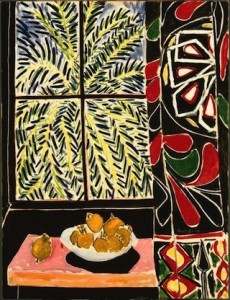 Again and again, I had this sort of reaction to specific paintings: oh, so that’s what he was up to with this one. Granted, it may have less to do with the exhibition itself than with the way I’ve learned to pay better attention to Matisse, but the selection of work had just as much to do with it. Hyperallergic has a fine examination of Interior with an Egyptian Curtain, in which Thomas Micchelli convinces me that Matisse managed to fit three different paintings into one with this work: the eponymous curtain, the palm tree you can see through the window and the still life in the lower left. What startled and delighted me was nothing more than the color of the table at the bottom of the painting. The surface of the table is a rich, almost purplish pink—there must be a name for the color, but it’s so varied and rich, the utter opposite of the flat, controlled regions of color in The Large Blue Dress—as well as in other parts of this painting itself. For the front of the table, Matisse chose a distinctly different but related hue, with traces of that pink, but closer to salmon, rust, with far more orange. The color is complex, alive, a balance between intent and accident in the way the grain of the minerals settled into the medium as it dried. In the catalog plate, you get a hint of those rich strips of color, with the blob of pure black shadow under the bowl for contrast, but if you’re ever at the Phillips Collection, check to see if this one’s on view. Those two little strips of color representing a table are what Matisse is all about for me–an intensity he both luxuriated in and kept restrained–and if you can find a word for what it is those two slightly different hues deliver, then you’ll have found a name for what it is that drives me to paint.
Again and again, I had this sort of reaction to specific paintings: oh, so that’s what he was up to with this one. Granted, it may have less to do with the exhibition itself than with the way I’ve learned to pay better attention to Matisse, but the selection of work had just as much to do with it. Hyperallergic has a fine examination of Interior with an Egyptian Curtain, in which Thomas Micchelli convinces me that Matisse managed to fit three different paintings into one with this work: the eponymous curtain, the palm tree you can see through the window and the still life in the lower left. What startled and delighted me was nothing more than the color of the table at the bottom of the painting. The surface of the table is a rich, almost purplish pink—there must be a name for the color, but it’s so varied and rich, the utter opposite of the flat, controlled regions of color in The Large Blue Dress—as well as in other parts of this painting itself. For the front of the table, Matisse chose a distinctly different but related hue, with traces of that pink, but closer to salmon, rust, with far more orange. The color is complex, alive, a balance between intent and accident in the way the grain of the minerals settled into the medium as it dried. In the catalog plate, you get a hint of those rich strips of color, with the blob of pure black shadow under the bowl for contrast, but if you’re ever at the Phillips Collection, check to see if this one’s on view. Those two little strips of color representing a table are what Matisse is all about for me–an intensity he both luxuriated in and kept restrained–and if you can find a word for what it is those two slightly different hues deliver, then you’ll have found a name for what it is that drives me to paint.
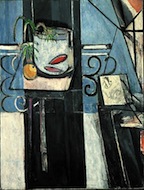 Finally, one last revelation: when I stood maybe a foot away from Goldfish and Palette, I could see how much Matisse had worked on the painting, covering over previous work without entirely obscuring it. When you see the painting as a color catalog plate, you won’t recognize any of this at all. In the catalog, it looks far simpler in execution. There’s a rectangle of creamy white, slightly pink, in the lower left corner, and it does look as if some previous work is covered over, but up near the actual painting it’s astonishing how complex and busy this earlier, now obscured work got. Maybe he scraped off successive coats or found himself noodling around, losing his bearings, and then simply went over it all with the white, not really concerned to completely cover his tracks. To the right of that rectangle there’s a thin strip of alizarin, which, if you get close enough you can see is a complex mix of red and green, painted and then scratched away, as Matisse loved to do, drawing with his knife. It’s an incredibly busy, almost expressionist-looking strip of paint, all random scribbles, and now looking at the reproduction, I suspect it’s one small glimpse of what the central shaft of black has covered up—that this same sort of work lurks behind all that black and Matisse simply wanted one small taste of it to show, maybe to preserve a little accent of the color that might have once taken up a third of the painting, or maybe for the contrast between the sense of detail all that scratching offers—or for whatever seemed like a good reason at the time. But leaving that little strip of earlier work to show in the final work was a purely improvisational moment in a painting that looks severely constructed, a scene strenuously reduced into flat geometry, including the artist’s palette, thumb and knee, visible in the lower right, which are almost unrecognizable until you see the thumb.
Finally, one last revelation: when I stood maybe a foot away from Goldfish and Palette, I could see how much Matisse had worked on the painting, covering over previous work without entirely obscuring it. When you see the painting as a color catalog plate, you won’t recognize any of this at all. In the catalog, it looks far simpler in execution. There’s a rectangle of creamy white, slightly pink, in the lower left corner, and it does look as if some previous work is covered over, but up near the actual painting it’s astonishing how complex and busy this earlier, now obscured work got. Maybe he scraped off successive coats or found himself noodling around, losing his bearings, and then simply went over it all with the white, not really concerned to completely cover his tracks. To the right of that rectangle there’s a thin strip of alizarin, which, if you get close enough you can see is a complex mix of red and green, painted and then scratched away, as Matisse loved to do, drawing with his knife. It’s an incredibly busy, almost expressionist-looking strip of paint, all random scribbles, and now looking at the reproduction, I suspect it’s one small glimpse of what the central shaft of black has covered up—that this same sort of work lurks behind all that black and Matisse simply wanted one small taste of it to show, maybe to preserve a little accent of the color that might have once taken up a third of the painting, or maybe for the contrast between the sense of detail all that scratching offers—or for whatever seemed like a good reason at the time. But leaving that little strip of earlier work to show in the final work was a purely improvisational moment in a painting that looks severely constructed, a scene strenuously reduced into flat geometry, including the artist’s palette, thumb and knee, visible in the lower right, which are almost unrecognizable until you see the thumb.
With that little strip of scribbled color that you’ll probably never discern in a reproduction of the painting, it’s almost as if Matisse is saying, “Look at what I need to tame.”
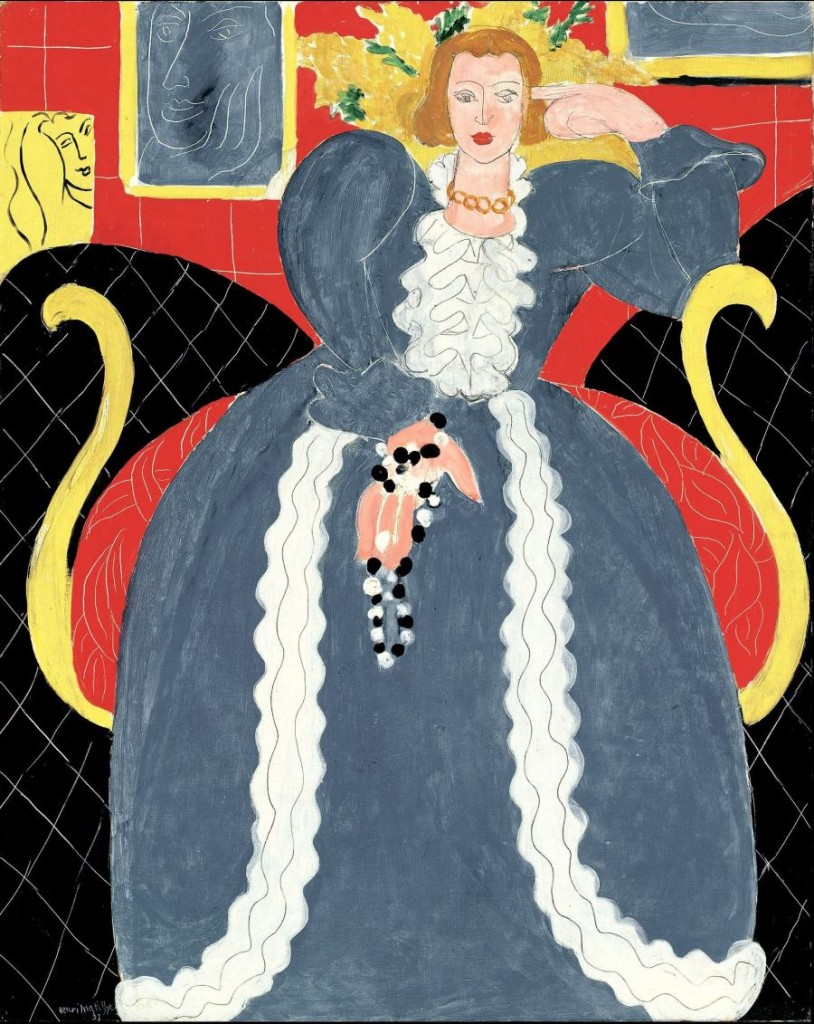
Comments are currently closed.